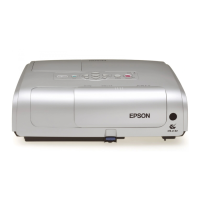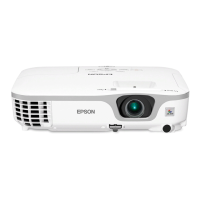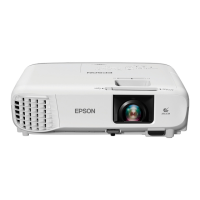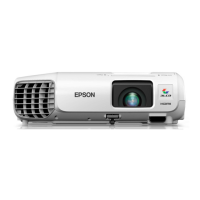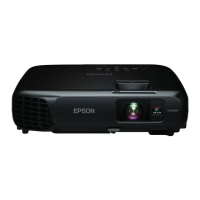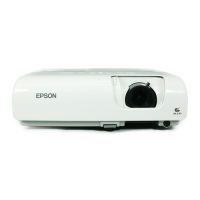
Do you have a question about the Epson PowerLite S5 Series and is the answer not in the manual?
| Resolution | 800 x 600 (SVGA) |
|---|---|
| Contrast Ratio | 400:1 |
| Weight | 2.7 kg (6.0 lbs) |
| Projection System | 3LCD, 3-chip technology |
| Lamp Type | 170 W UHE |
| Lamp Life | 3000 hours (Normal Mode) |
| Zoom Ratio | 1.35x |
| Projection Size | 30" to 300" |
| Input Ports | Composite Video (RCA), S-Video (Mini DIN 4-pin), Audio (Stereo Mini Jack), VGA (HD D-sub 15-pin) |
| Output Ports | VGA (HD D-sub 15-pin) |
| Noise Level | 37 dB (Normal Mode), 30 dB (Low Brightness Mode) |
Guide on deciding where to place the projector for optimal image size and viewing.
Instructions for connecting the projector to various computer types via VGA or BNC ports.
Step-by-step guide to connect the projector to a computer using the included VGA cable.
Instructions for connecting the projector to a computer with BNC output using a VGA-5BNC cable.
Enables using the remote control for slideshow navigation via a USB connection.
How to connect an external monitor for simultaneous display with the projector.
Connect an audio adapter cable to play sound from your computer or video device.
Connect various video devices like DVD players, VCRs, and cameras to the projector.
Steps to connect a video source using a standard RCA A/V cable.
Connect a video source with an S-Video jack for higher quality images.
Connect a video player or satellite receiver with an RGB output using the VGA cable.
Use a component video cable for higher quality video images from compatible sources.
Procedure to power on the projector and connected computer or video equipment.
How to switch between different connected video and computer sources.
Guide to focus, zoom, adjust height, shape, brightness, and color of the projected image.
Recommended steps to safely turn off the projector and connected equipment.
Use the remote to select sources, adjust volume, and control picture settings.
Freeze the current image on the screen while sound continues.
Enlarge a specific portion of the projected image using the remote's zoom function.
Adjust the image aspect ratio between widescreen (16:9) and standard (4:3).
Navigate through presentation slides remotely using Page Up/Down buttons.
Instructions for replacing the two AA batteries in the remote control.
Overview of the six projector menus for adjusting image, signal, and settings.
Steps to navigate menus and adjust various projector settings using the remote or buttons.
Fine-tune image colors, brightness, contrast, and sharpness via the Image menu.
Manually adjust input signal settings like tracking, sync, and aspect ratio.
Personalize projector settings like lamp brightness, volume, and security controls.
Configure projector for rear/ceiling projection, menu language, and startup screens.
Check lamp hours, input source, resolution, and other status information.
Prevent unauthorized use by setting passwords, user logos, and button locks.
Capture and transfer a custom image or logo for startup or A/V Mute screens.
Establish a 4-digit password to prevent unauthorized projector operation.
Use Operation Lock to disable projector buttons, except the Power button.
Return most projector menu settings to their original factory default values.
Instructions for removing dust and smudges from the projector lens.
How to clean the projector's exterior using a soft cloth and mild detergent.
Procedure for cleaning or replacing the air filter to prevent overheating.
Step-by-step guide on how to replace the projector's projection lamp.
Clear the 'Replace Lamp' warning and reset the lamp usage timer after replacement.
Guidelines for safely packing and transporting the projector to prevent damage.
Access the projector's help system for troubleshooting image or audio issues.
Interpret projector status lights and find solutions for error conditions.
Troubleshoot issues like no image, blank screen, blurry images, or no sound.
Guidance for forgotten passwords and issues with password protection.
Troubleshoot situations where the projector does not respond to remote commands.
Display type, lens specifications, color reproduction, and image size details.
Power consumption and expected lifespan of the projection lamp.
Specifications for the remote control's range, batteries, and compatibility.
Physical measurements including height, width, depth, and weight.
Details on rated frequency, power supply, and power consumption.
Operating and storage conditions for temperature, humidity, and altitude.
Compliance information for United States, Canada, and CE marking.
Supported video standards and their corresponding refresh rates.
Supported computer display resolutions and refresh rates for optimal projection.
Essential safety precautions for setting up, using, and maintaining the projector.
Conditions affecting remote control operation and common troubleshooting steps.
Compliance information and warnings regarding radio frequency interference.


